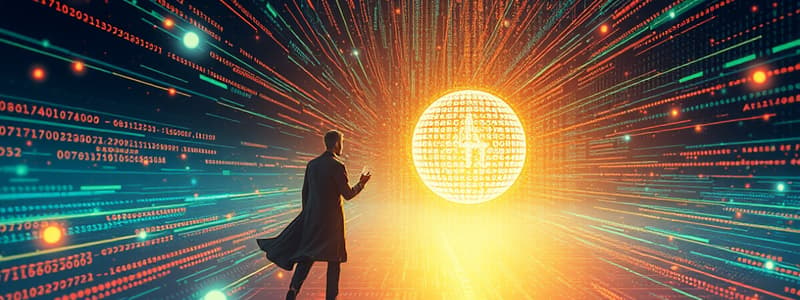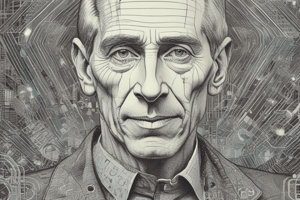Podcast
Questions and Answers
What role does information theory play in the context of data communication?
What role does information theory play in the context of data communication?
- It describes the physical construction of communication devices.
- It focuses on the storage capacity of data files.
- It analyzes the visual representation of information flow.
- It represents conditions affecting the transmission and processing of information. (correct)
Which of the following statements best differentiates information theory from communication theory?
Which of the following statements best differentiates information theory from communication theory?
- Information theory deals exclusively with digital signals.
- Communication theory emphasizes the limitations of information processing.
- Information theory is more concerned with fundamental limitations on processing and communication. (correct)
- Communication theory focuses on analog signals exclusively.
In data communication, what is essential for enabling the movement of data between nodes?
In data communication, what is essential for enabling the movement of data between nodes?
- The physical distance between nodes is minimized.
- The synchronization of clocks between devices.
- The optimization of analog signals only.
- The existence of a defined technological medium. (correct)
How does ASCII code contribute to data communication?
How does ASCII code contribute to data communication?
What aspect of data communication is least affected by geographical location?
What aspect of data communication is least affected by geographical location?
What is the primary characteristic of a personal area network (PAN)?
What is the primary characteristic of a personal area network (PAN)?
Which type of network is specifically designed to interconnect local area networks (LANs) within a city?
Which type of network is specifically designed to interconnect local area networks (LANs) within a city?
Which of the following is a valid example of a wide area network (WAN)?
Which of the following is a valid example of a wide area network (WAN)?
Which statement accurately differentiates LANs from PANs?
Which statement accurately differentiates LANs from PANs?
What is the general coverage area of Local Area Networks (LANs)?
What is the general coverage area of Local Area Networks (LANs)?
Flashcards are hidden until you start studying
Study Notes
Data Communication Basics
- Words are translated into binary using formats like ASCII code, transmitted via analog or digital signals.
- Information theory, developed by Claude Shannon, examines conditions and limitations influencing information transmission and processing.
- Communication theory overlaps with information theory but focuses more on the limitations rather than device operations.
Data Communication Definition
- Data communication involves the exchange of information between a source and a receiver within a network.
- It facilitates the transfer of electronic or digital data between multiple nodes, regardless of their location or the medium used.
Types of Networks
- Personal Area Networks (PANs): Cover devices within approximately 10 meters, typically personal devices like smartphones and tablets.
- Local Area Networks (LANs): Span small geographical areas, usually within a building or campus; examples include Ethernet and Token Ring.
- Metropolitan Area Networks (MANs): Connect multiple LANs over a larger campus or city area; an example is the Fiber Distributed Data Interface (FDDI).
- Wide Area Networks (WANs): Extend across larger regions such as countries or globally; examples include the Public Switched Telephone Network (PSTN) and the Internet.
Components of Data Communication
- Source: Generates information (e.g., computers, tablets).
- Source Encoder: Converts information into an electrical format (e.g., modem).
- Transmitter: Converts message signals into a channel-acceptable form (e.g., amplifiers and antennas).
- Channel: Represents the pathway linking transmitter and receiver, can be physical (wires) or RF signals.
- Receiver: Functions inversely to the transmitter to retrieve the message signal (e.g., filters and antennas).
- Source Decoder: Converts back the electrical signal to a receiver-acceptable form (e.g., modem).
- Sink: End-user of the generated information (e.g., computers, smartphones).
Network Topology
- Point-to-Point (P2P): Direct link connecting two nodes or devices permanently.
- Point-to-Multipoint: One node linked to multiple nodes, where each connection is P2P.
- Tree Topology: Configured by connecting multiple buses in a branching structure without closed loops.
Studying That Suits You
Use AI to generate personalized quizzes and flashcards to suit your learning preferences.




